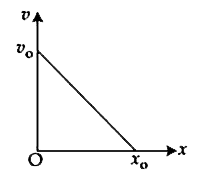Assertion: In S.H.M., the velocity and displacement of the particle are in the same phase.
Reason: Velocity is the ratio of displacement to the time taken.
Assertion is True, Reason is True, Reason is a correct explanation for Assertion
Assertion is True, Reason is True, Reason is not a correct explanation for Assertion
Assertion is True, Reason is False
Assertion is False but, Reason is True.
The correct Answer is:D
To solve the assertion-reason question, we need to analyze both the assertion and the reason provided.
1. Understanding the Assertion:
The assertion states that in Simple Harmonic Motion (S.H.M.), the velocity and displacement of the particle are in the same phase.
2. Displacement in S.H.M.:
In S.H.M., the displacement x of a particle can be expressed as:
x(t)=Asin(ωt)
where A is the amplitude and ω is the angular frequency.
3. Calculating Velocity:
The velocity v of the particle is the time derivative of displacement:
v(t)=dxdt=ddt(Asin(ωt))=Aωcos(ωt)
4. Phase Relationship:
The displacement x(t)=Asin(ωt) is in the sine function, while the velocity v(t)=Aωcos(ωt) is in the cosine function.
5. Phase Difference:
The cosine function can be expressed in terms of sine:
cos(ωt)=sin(ωt+π2)
This indicates that the velocity is π2 radians (or 90 degrees) ahead of the displacement in phase.
6. Conclusion on the Assertion:
Since the phase difference between displacement and velocity is π2, they are not in the same phase. Therefore, the assertion is false.
7. Understanding the Reason:
The reason states that velocity is the ratio of displacement to the time taken. This is indeed true, as velocity v is defined as:
v=dxdt
This statement is correct, but it does not support the assertion.
8. Final Conclusion:
The assertion is false, and the reason is true. Thus, the correct answer is that the assertion is false and the reason is true.
Summary:
- Assertion: False
- Reason: True
The assertion states that in Simple Harmonic Motion (S.H.M.), the velocity and displacement of the particle are in the same phase.
In S.H.M., the displacement x of a particle can be expressed as:
x(t)=Asin(ωt)
where A is the amplitude and ω is the angular frequency.
The velocity v of the particle is the time derivative of displacement:
v(t)=dxdt=ddt(Asin(ωt))=Aωcos(ωt)
The displacement x(t)=Asin(ωt) is in the sine function, while the velocity v(t)=Aωcos(ωt) is in the cosine function.
The cosine function can be expressed in terms of sine:
cos(ωt)=sin(ωt+π2)
This indicates that the velocity is π2 radians (or 90 degrees) ahead of the displacement in phase.
Since the phase difference between displacement and velocity is π2, they are not in the same phase. Therefore, the assertion is false.
The reason states that velocity is the ratio of displacement to the time taken. This is indeed true, as velocity v is defined as:
v=dxdt
This statement is correct, but it does not support the assertion.
The assertion is false, and the reason is true. Thus, the correct answer is that the assertion is false and the reason is true.
- Assertion: False
- Reason: True
Topper's Solved these Questions
- BOOK - TARGET PUBLICATIONCHAPTER - OSCILLATIONS EXERCISE - COMPETITIVE THINKING135videos
OSCILLATIONS
- BOOK - TARGET PUBLICATIONCHAPTER - OSCILLATIONS EXERCISE - EVALUATION TEST14videos
OSCILLATIONS
- BOOK - TARGET PUBLICATIONCHAPTER - OSCILLATIONS EXERCISE - EVALUATION TEST14videos
OSCILLATIONS
- BOOK - TARGET PUBLICATIONCHAPTER - MODEL QUESTION PAPER EXERCISE - MODEL QUESTION PAPER -II47videos
MODEL QUESTION PAPER
- BOOK - TARGET PUBLICATIONCHAPTER - QUESTION PAPER 2019EXERCISE - MCQ45videos
QUESTION PAPER 2019
Similar Questions
Knowledge Check
- Question 1 - Select One
Graph between velocity and displacement of a particle, executing S.H.M. is
AA straight lineBA parabolaCA hyperbolaDAn ellipse - Question 2 - Select One
A particle executes SHM. Then the graph of velocity as a function of displacement is
AA circleBA parabolaCAn ellipseDA helix - Question 3 - Select One
The displacement of a particle in S.H.M. in one time period is
AAB2AC4ADZero
Assrtion o (A) : A body may have velocity and displacement in the oppostie direction
Reason (R) : Velocity is distance travellled by the body in a unit timeView SolutionA particle is executing SHM. Then the graph of velocity as a function of displacement is
View SolutionAssertion : The gerph between velocity and displacement for a harmonic oscillation is a parabola
Reason : Velocity does not change uniformly with displacement in simple harmonic motionView SolutionA particle executing SHM. The phase difference between velocity and displacement is
View SolutionIf the time-displacement graph of a particle is parallel to the-axis, the velocity of the particle is
View Solution


